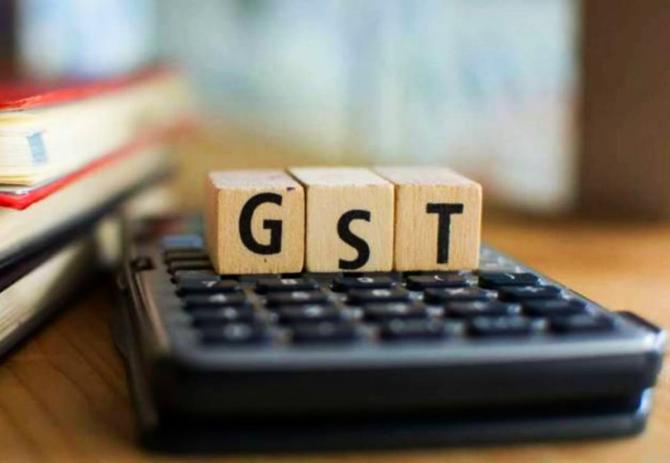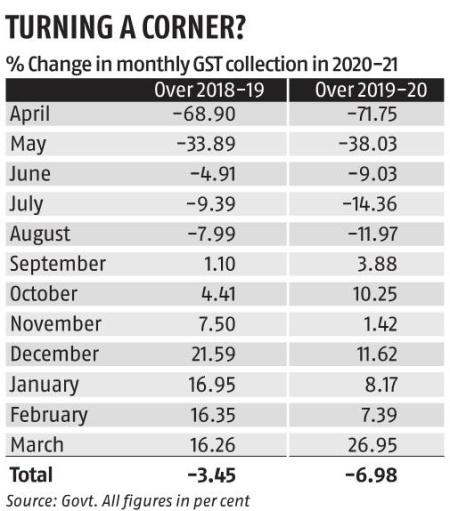Any judgement on whether the March numbers reflect sustainable growth in GST collection should ideally await the numbers that will be out in May, points out A K Bhattacharya.

The amount of goods and services tax (GST) collected in March 2021 has triggered a wave of celebrations within the government and even among the analyst community. This is not entirely unexpected.
At Rs 1.24 trillion in the last month of 2020-2021, it is the highest monthly collection since the launch of GST in July 2017.
What's more, the collection in March meant that for the sixth month running, in a pandemic year, the government has managed to get more than Rs 1 trillion in its GST kitty.
Does it then mean that the GST numbers reflect the economic recovery that was keenly awaited?
Does it also mean that the many glitches in the GST collection system have been removed, giving rise to a general revenue buoyancy?
And finally, should this embolden the government, in the Centre and states, to go for further rationalisation of tax rates and inclusion of petrol and diesel under GST?
Any attempt to answer these questions will require a deeper understanding and analysis of the GST collection numbers.
First, it is important to recognise that the March collection numbers do not reflect the tax payment on the goods and services transactions that took place in March.
In the GST system, taxes are usually paid about a month after the transactions, based on the filing of returns and adjustment of refunds.
It is, therefore, reasonable to assume that the buoyancy in tax revenue in March 2021 is based on the transactions that took place in February.
This is not the usual bump in revenue collection that is witnessed in the last month of a financial year.
Any judgement on whether the March numbers reflect sustainable growth in GST collection should have ideally awaited the numbers that will be out in May.
But, with the resurgence of COVID-19 infections and the consequent restrictions being imposed on economic activities, even such a judgement has to wait for a few more months.
GST collection in March 2021 also needs to be placed in the context of a slightly longer timeframe.
GST revenue of Rs 1.24 trillion in March 2021 represents a 27 per cent increase over the collection in March 2020.
And if you compare the March 2021 collection with that in March 2019, the growth in revenue comes to a lower figure of 16 per cent.
The puzzle begins here. Remember that the pace of economic activity had begun to be adversely affected only from the third week of March 2020 in view of the COVID-19 outbreak.
Since the March 2020 collection was based on transactions in the previous month, which was relatively free from any adverse impact of the pandemic, it would be reasonable to assume that they reflected a general slowdown, yet to be impacted by COVID-19.
So, the March 2021 growth in GST collection looks quite impressive.
In any case, a growth rate of 16 to 27 per cent should cheer anybody under any circumstances.
And yet, there is no certainty that this growth momentum can be maintained in April 2021 or in the succeeding months, thanks to the resurgence of the COVID-19 cases.
A close look at the monthly GST collection in 2020-2021, 2019-2020 and 2018-2019 is also instructive.
Even though GST collection in 2019-20 should not have been adversely affected by COVID-19, the overall revenue showed signs of an economic slowdown.
For the entire year of 2019-2020, the total GST collection grew by less than 4 per cent over 2018-2019.
On a month-on-month basis also, the growth rate in 2019-2020 over the previous year reached double digits only once during the whole year and saw a contraction in as many as three months.

It is reasonable to conclude that GST collection growth in 2019-2020 was tepid not because of COVID-19, but because of the economic slowdown and the disastrous decision taken in December 2018 to introduce rate cuts on a large number of items without any corresponding increase to protect the revenue neutral rate.
It was more than a double whammy. GST collection suffered in 2019-2020 on account of reduced rates and an economic slowdown. In addition, there were many glitches in the collection procedures.
The pressure on revenue collection increased with the COVID-19 outbreak and the first five months of 2020-2021 bore the brunt of not just the pandemic-induced lockdown, but also of the reduced rates and the glitches in the revenue collection procedures.
Indeed, GST revenue contracted in each of the months from April to August (See table).
Growth returned from September onwards. Initially, it was patchy, but it got better from December.
There was closer monitoring of fake billing. The tax authorities began using data from multiple sources, including GST, income-tax and Customs to track transactions to prevent evasion. The technology backbone for collecting GST was also strengthened.
So, what does the future trend of GST collections look like? The improvements in tax administration will continue to yield benefits for the GST collection system in the coming months.
But the resurgence of COVID-19 cases can be a spoiler.
The key question is whether the Union and state governments agree to undoing the wrong that was perpetrated in December 2018.
If they can examine the question of rationalising the rates to neutralise the ill-effects of the decisions taken at the 31st meeting of the GST Council, achieving sustainable growth in GST revenue in 2021-2022 could be a possibility, provided the adverse impact of Covid-19 on economic activity can be contained.
Feature Presentation: Rajesh Alva/Rediff.com










